
The Theosophical Society (Jamshed Memorial Hall)
Located on M.A Jinnah Road, the Theosophical Society’s main auditorium was named after Jamshed Nusserwanjee, the philanthropist and humanitarian who was Karachi’s first mayor, popularly known as “The Builder of Modern Karachi”. The Jamshed Memorial Hall was renovated in the 1950s, but it is only one aspect of the building that housed the Karachi branch of the Theosophical Society, founded in 1896, which now consists of a Montessori school, a lecture room, and two libraries, one of which is amongst the city’s oldest. The Theosophical Society remains a bastion of tolerance and theological-philosophical reflection in Karachi, as seen in the key tenets of the Society: “to form a nucleus of the universal brotherhood, without distinction of race or colour; to encourage the study of comparative religion, philosophy and science; and to investigate unexplained laws of nature.”
Participating Artists:
Tazeen Qayyum
Born in 1973 in Karachi (Pakistan)
Lives and works in Oakville, ON (Canada)
Tazeen Qayyum is a contemporary visual artist who received her BFA in Visual Arts from the National College of Arts Lahore, Pakistan in 1996. Her work has been shown internationally in both solo and group exhibitions, some of which include ‘Holding Pattern’ at the Toronto Pearson Airport, 'The Veiled' at the Textile Museum of Canada, 'The Rising Tide’, Mohatta Palace Museum, Pakistan, ‘Urban Myths & Modern Fables’, University of Sydney, Australia and UTSC, Toronto, ‘A Thousand and One Days’ at the Academy of Art, Honolulu, Hawaii, ‘JAALA Exhibition at the Tokyo Metropolitan Museum, Japan, ‘Homecoming’, at the National Gallery of Pakistan and 'CodeLive Metro' at the 2010 Vancouver Winter Olympics. She was nominated for the Jameel Prize (2013) and K.M. Hunter Award (2014), and received the Excellence in Art Award 2015 by the CCAI (Canadian Community Arts Initiative). Qayyum's work was included in the 10th Asian Biennale, Dhaka, Bangladesh (2002), 2nd Painting Biennale, Tehran, Iran (2002) and was awarded a UNESCO bursary (2000) to work and exhibit in Vienna.
Of her work for KB17, Tazeen Qayyum states: “Facade is a site-responsive immersive installation that takes the Karachi Biennial’s theme ‘Witness’ and asks how we as a Pakistani society have become desensitized to the growing violence, intolerance and prejudice and how such actions are mimicking and reflecting the growing western rhetoric of non-inclusive religious ideas and insolence towards other faiths. Installed at the historic and important site of Jamshed Memorial Hall in Karachi, which houses the Theosophical Society, Facade is an outward exploration of the ideology and teachings of the society which is based on universal brotherhood (without distinction of race or colour) and to encourage the study of comparative religion, philosophy and science. Taking advantage of the site’s architectural history, function, and the survival history of the Society in the community, the front façade of the building is delicately painted with ornate pattern of interlocking shapes of a household cockroach. The resulting installation not only masks the building under an ornate veil of grotesque beauty, it also mirrors the environment, engaging passers-by with wonder and curiosity. The painted pattern pays homage to the exquisite tile work on religious structures, graffiti art and wall chalking whereas its subtle macabre humour, engages the audience to ponder meaning of inclusion, tolerance, hope and resilience. The repeated forms and the message of Façade that are observed as outward communal engagement is then witnessed in the drawing based performance Unvoiced, as an inward expression of meaningful reconciliation and endless compassion.”
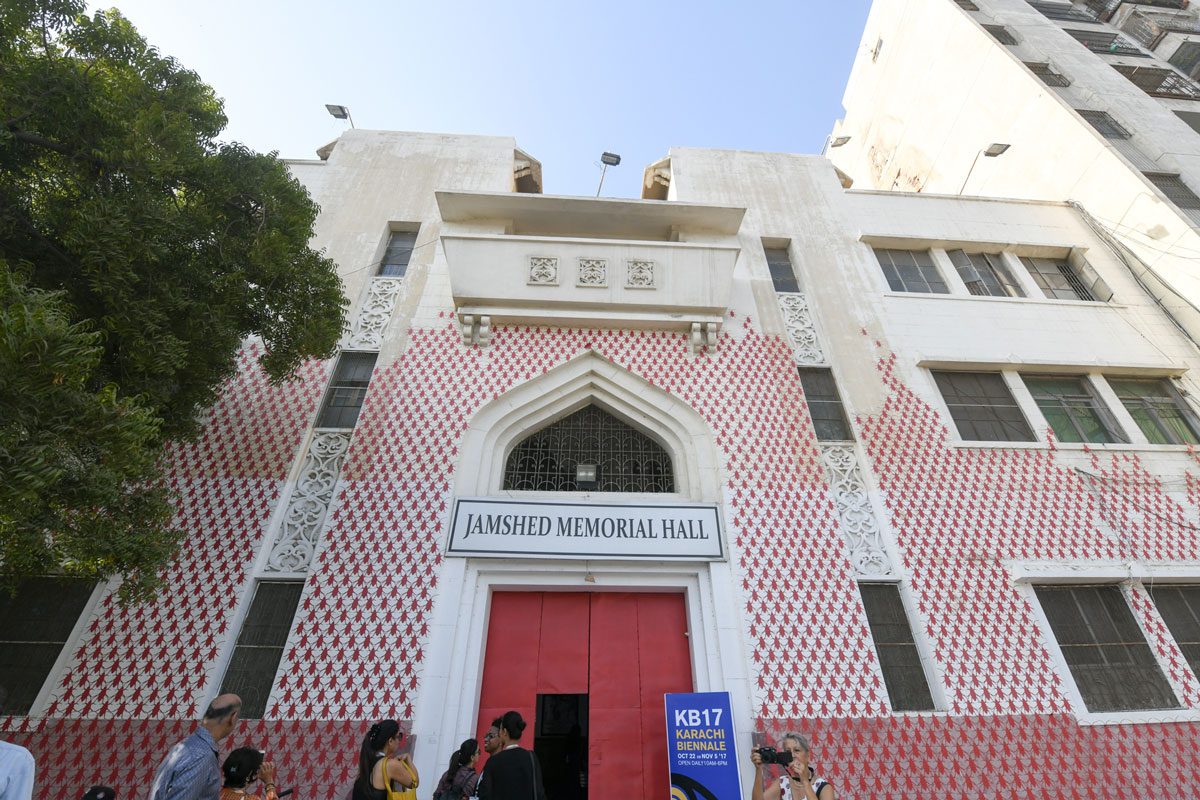
Façade, 2017.
Site-responsive Installation
Madiha Aijaz
Born in 1981 in Multan (Pakistan)
Lives and works in Karachi (Pakistan)
Madiha Aijaz works with photography, film and fiction. A recipient of the Fulbright Scholarship, she holds an MFA in Photography & Related Media from Parsons – The New School for Design. Her photographic work on Hindu temples in Pakistan was published in, Historic Temples in Pakistan – A Call to Conscience, in 2014. She is currently developing a documentary feature on travelling fairs and performers in Pakistan, in collaboration with film-maker Maheen Zia, which has received support from Locarno’s Open Doors Programme and the IDFA Bertha Fund. Aijaz works as an Assistant Professor at the Indus Valley School of Art and Architecture, Karachi. Aijaz’s art practice explores the liminal zone between fiction and reality that the camera, as a vehicle of representation, often accords. Photographically, she aims to read and transpose the instinctual unconsciousness in its unfolding, simultaneously investigating the veracity and theatricality of her subject, imbuing her work with a veristic equivocality that corresponds to our own ocular experience of the world.
Aijaz’s work for the Karachi Biennale 2017 studies the public libraries of Karachi and the librarians who have been obstinately holding the fort at such institutions whilst the context of the city has transformed, in many cases, around them. This emphasis on the librarians themselves provides an insight into the migrant communities of the city, as well as the aging intelligentsia – many of whom are bastions of a foregone era. Such a study, working in a combination of photography, film and text, is also a reading of the shifting context that has shaped the content in the libraries; the content being a tangible barometer of the city’s cultural trajectory throughout the years. The work itself is part of the fabric of the shelves in the Theosophical Society’s Library, one of the oldest public libraries that remains in Karachi, with publications dating back to the 1890s, perfectly consummating Aijaz’s concept and its realisation, with the artwork becoming a part of the library.
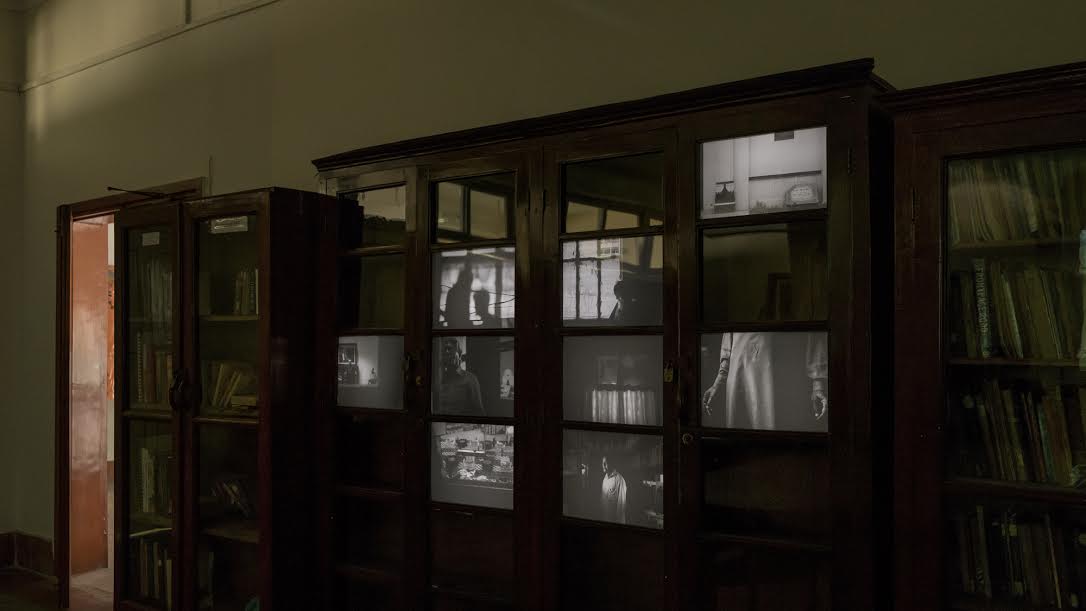
These Silences Are All the Words, 2017.
Photographs and a two channel video projection
Courtesy the artist
Birgitta Hosea
Born in 1965 in Edinburgh (UK)
Lives and works in London (UK)
Birgitta Hosea is a media artist and curator who works in expanded animation and experimental drawing. She studied Film and Drama at Glasgow University and Theatre Design at Glasgow School of Art. Previously Course Director of MA Character Animation at Central Saint Martins in London, where she was awarded a practice-based PhD in Animation as Performance in 2012, she is currently Head of Animation at the Royal College of Art in London. Hosea's work takes a conceptual approach to the moving image that draws upon historical and theoretical research into the discipline. Rather than using animation to create short films, her personal work is concerned with deconstructing conventional ideas about animation and exploring different expanded forms that the recording of time and motion could take. Combining animation, video, interactive technology, drawing, and live performance, her practice explores animism: the vital spark of movement that brings the still and lifeless into motion. She is also interested in how the media that surrounds us and the very movements we make - our gestures and actions - lead us to construct our identity: in particular how we perform our gender identity.
The video on view at KB17 is a documentation of a performance that was done in an exhibition called “gHost IV” that was curated by Sarah Sparkes at the Crypt of St Johns, Bethnal Green, London in 2012. Taking the role of a techno-medium, Hosea channels messages from film and radio through her multiple digital doubles and live projections of automatic writing, electronic ectoplasmic drawing and animation. Inspired by archival research into Victorian spirit photographs, which are amongst the earliest examples of photographic manipulation, this tableau vivant explores the act of mediation that is involved in the digital image making process. It examines the connections between a medium, such as film or digital code, through which a message is encoded, stored and transmitted and the psychic medium, a person who transmits messages from the spirit world. The words in the soundtrack are sampled from two classic films in which human beings mediate between the world of the living and the world of the dead. June, the radio operator from A Matter of Life and Death (Powell and Pressburger, 1946), picks up radio transmissions from a WW2 pilot on the verge of death: “Are you receiving me?” The housekeeper Mrs Danvers thinks she hears her departed mistress walking through the corridors of her former home, Manderlay: “Sometimes I hear her.” (Rebecca, Hitchcock, 1940)

Medium, 2012.
Video, 10 min. (looped)
Projected animation, manipulated video, live digital drawing and performance
Collection of the artist
All photos by Caroline Kerslake
Sanki King
Born in 1990 in Jeddah (Saudi Arabia)
Lives and works in Karachi (Pakistan)
Sanki King is a self-taught street artist, pioneering the bourgeoning discipline in Pakistan. He is a member of two of the most respected graffiti crews in the world: BMK (Beyond Mankind Krew), established in 1991 in Queens, New York; and Ex-Vandals (Experienced Vandals), established in 1978 in Brooklyn, New York. Since 2012, Sanki King has produced some of the largest single-artist works of graffiti in Pakistan, creating work in seven different languages to date. In 2015, his work was published in a book of global street art, Street Messages by Nicholaz Ganz, which also includes the artwork of world-renowned street artists, such as Banksy, El Seed and Ben Eine. He has also given a number of talks around Pakistan, most notably at: the Young Leaders Conference, Karachi; TEDxNustKarachi; and TEDxNEDUniversity. Sanki King’s work has been exhibited at Sanat Initiative Gallery, Karachi; VM Art Gallery, Karachi; the 1st Sindh Literature Festival, Karachi and Soul Patch, Mumbai. King will feature in Season Three of Interrupt This Program, an award-winning Canadian series of television documentaries exploring ‘underground’ art scenes. King’s artistic practice derives its inspiration from textual structure, linguistics and literature, manifesting itself in an ever-modulating style which could most often be described as a kind of futuristic street calligraphy.
In Sanki King’s site-specific project, Mind Palace, which inhabits and unfurls itself across the rooftop of The Theosophical Society, he has taken the location and its interaction with his graffiti to be a representation of his mind, deliberately exposed and made public. In fact, the architectural context of the rooftop, as surrounded by dilapidated apartment blocks, entails that the audience for the work is very much the public – the local residents who have witnessed the entire process of the realisation of King’s work. The painting, osmotically diffused throughout the rooftop’s topography, is based on writings of King’s own composition, collectively entitled Freedom of Thought. The work openly enters into multifarious dialogues: with its setting and the context of Karachi; with the concept of exhibition space; with preconceived definitions of art genres, especially street art and calligraphy; and with the viewer, in that it allows them access to the artist’s internal thought process, creating a discourse between the two divergent internal perspectives. The viewer, in a literal sense, is able to enter, walk and exist within King’s artistic representation of his consciousness, his psyche, his Mind Palace.
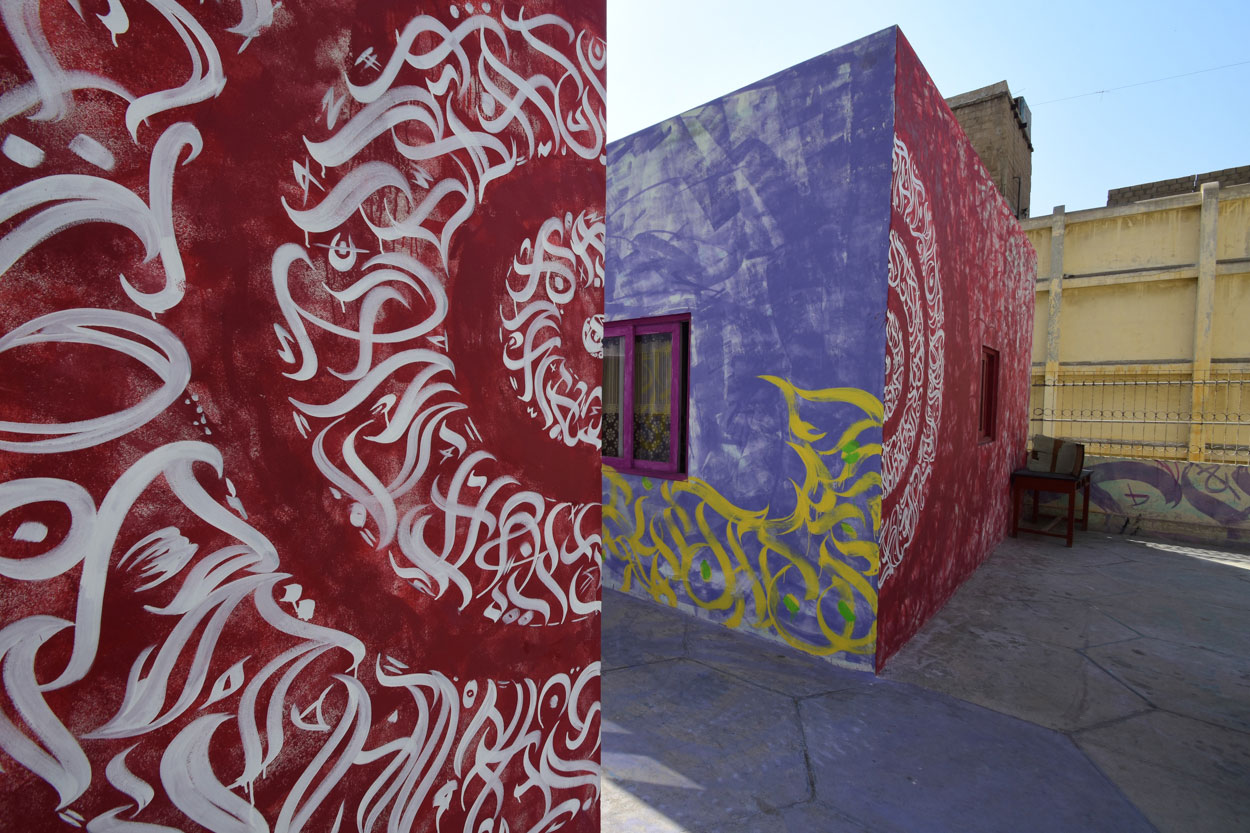
Mind Palace, 2017.
Grafitti
Akram Dost Baloch
Born in 1958 in Nushki (Pakistan)
Lives and works in Quetta (Pakistan)
Akram Dost Baloch was born in Nushki, a border town in the south-west of Balochistan province of Pakistan, and received his school education there. He graduated with his BFA from National College of Arts, Lahore, and is among the founding faculty of The Department of Fine Arts, University of Balochistan. He paints and sculpts and the themes of his work are wide ranging, with a heavy focus on human rights. The dominant aesthetics of his work are inspired by the traditional motifs of Balochistan, an area to which he has contributed much himself; Baloch wrote his PhD dissertation on the traditional patterns of Baloch embroidery and handicrafts, and has contributed invaluable items to the collection on Balochistan at the Mohatta Palace Museum in Karachi. Baloch has received wide acclaim, both at home and abroad, and is also the recipient of Pakistan’s President’s Pride of Performance award (2004). He is currently based in Quetta where he runs his studio and chairs The Institute of Fine Arts at University of Balochistan.
Akram Dost Baloch has an installation of 40 wooden boxes that he has carved upon on view at KB17. He writes: “Art for me serves two functions; first comes its redemptive quality, and second, its capacity to bear witness to, and speak for the despairing side of human existence. While the first raises us, it is only with a keen perception of the latter that the aching need for and the requisite perception to find redemption can be attained. Such has been the prime motive for my practice over these many years. My submitted work comprises 40 boxes, all of which I have carved with engraved compositions. The history of these boxes, which I purchased at an auction in Quetta, is a curious one: these were used by the British army for ammunition storage and languished in bunkers and warehouses at the Quetta fort after their departure in 1947. Quetta Fort itself was a military garrison built by the British upon the mound of an extant Qila (fortress) and served as the Raj’s furthermost western military station. The Qila, the British, the ammunition caches, and the cultural and political upheavals that have plagued the region since readily tie into a narrative that is not completely foreign to the themes of my work; their arrival and the legacy of their departure haunt the political, social and cultural developments of the subcontinent to this day.”
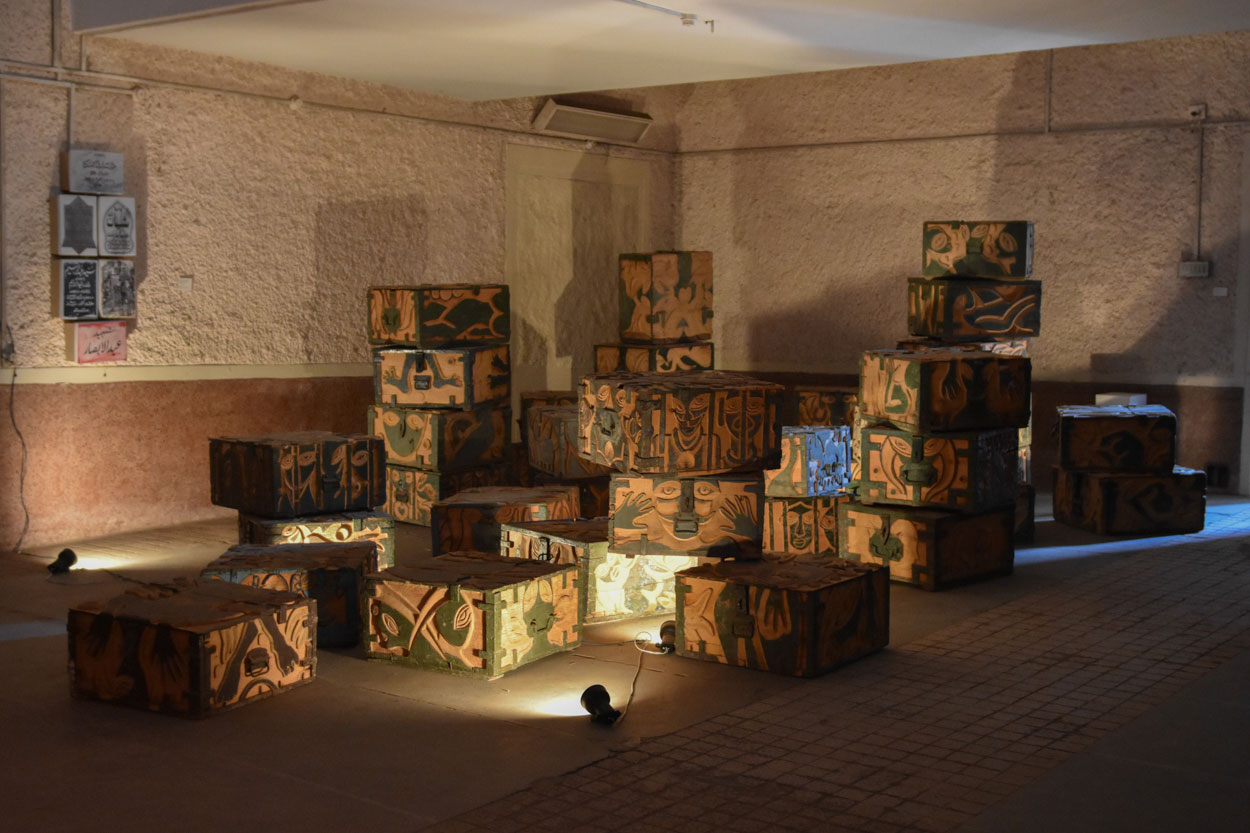
Of Yore and Lore, 2017.
Mixed media installation
Dimensions variable
Courtesy the artist
Munawar Ali Syed
Born in 1975 in Hyderabad (Pakistan)
Lives and works in Karachi (Pakistan)
Munawar Ali Syed is a multi-disciplinary artist specialising in three-dimensional mixed media, as well as performance and public art. He studied Fine Art at the National College of Arts, Lahore, obtained an MA in Fine Art from Beaconhouse National University, Lahore, and currently teaches at the Indus Valley School of Art and Architecture in Karachi. An active member of the Vasl Artist Collective, he has participated in multiple residencies and workshops, including: the Burragorang International Artists’ Workshop, Australia; the Vasl International Artists Workshop, Pakistan; the Braziers International Artist Workshop, England; and the Westbury Farm Residency, England. Along with exhibiting in several exhibitions both nationally and internationally, Munawar has had seven solo exhibitions. Recently, Munawar has taken on a new direction in his trajectory, this artistic change of tack fueled by his enthusiasm for public art. Accordingly, he has now curated four exhibitions which very much relied on heavy public participation, and has coordinated two public art projects, one reimagining Karachi’s city walls, and the other the ‘Great Wall of Truck Art’ at Islamabad Airport. His work has a self-reflective, existential flavor to it, addressing the issues one faces in an age of deception; a response to the proliferation of mass media, propaganda, and society’s general self-absorption and duality.
His installation for the Karachi Biennale 2017, Where Lies My Soul, visually emulates his artistic process of self-reflection, and acts as a witness to his artistic journey and art practice, both of which have been shaped by Munawar’s response to living in the urbanity of Karachi. By combining all the available sculptural pieces in his studio with books, drawings, carvings, framed art works, easels, and other pieces of general studio equipment, and wrapping this monolithic structure in a black sheet of plastic, he constructs his own artistic narrative that occupies the space somewhere between form, function and non-function, between the tangible and intangible, creating an ambiguity for the viewer which forces them to imagine what is wrapped inside. As an artist who specialises in three-dimensional mixed-media, Munawar’s Where Lies My Soul is a commentary on the nature of artistic production in relationship to imagery and imagination, art and non-art, among other dualities that are inherent in the artist’s multi-disciplinary concept and process. As Munawar states, “This block of wrapped objects is simultaneously an arrival and departure from my art practice.”
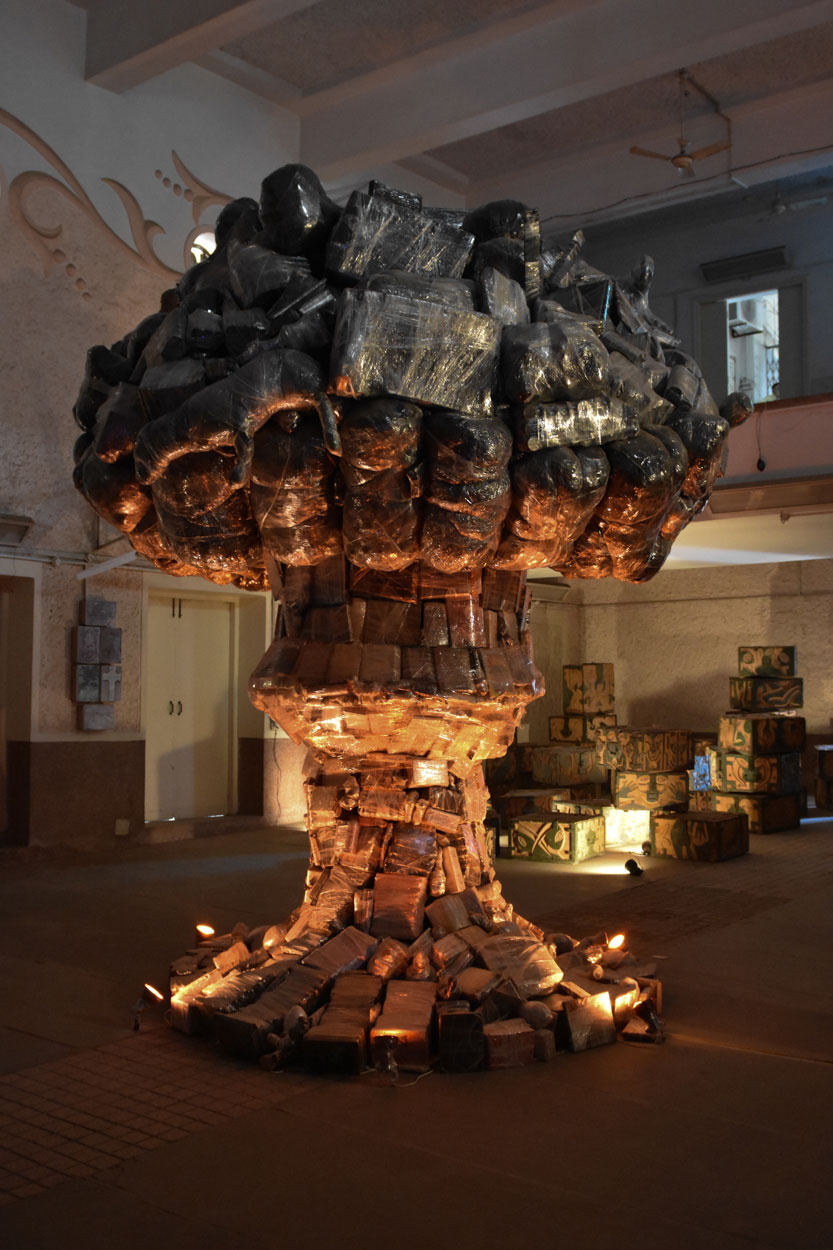
Where Lies My Soul, 2017.
Mixed media installation
240 x 240 x 240 cm.
Adeel uz Zafar
Born in 1975 in Karachi (Pakistan)
Lives and works in Karachi (Pakistan)
Adeel uz Zafar is a multi-disciplinary artist and illustrator, based in Karachi. Having obtained a BFA (with distinction) from the National College of Arts in 1998, his initial trajectory led him towards illustration, which has proven highly influential in his artistic practice. Whilst working as National Illustration Consultant for the Northern Areas Education Project in remote areas of Northern Pakistan, the absence of conventional artistic media forced Zafar to experiment with substitutes for paints and surfaces, precipitating the development of his characteristically reductive technique by engraving on exposed photographic sheet. Through obsessive repetition of this simple action of mark-making, he creates intricately textured forms imbued with a meditative and contemplative aesthetic. Zafar’s work has been exhibited nationally and internationally, with venues and art fairs including: Hinterland Galerie, Vienna; Lawrie Shabibi, Dubai; Art Stage Singapore; Art Basel, Hong Kong; Pulse Art Fair, New York; and the 2nd Kathmandu International Art Festival. Zafar has also held several national and international solo exhibitions, among them: Stranger than fiction at Gandhara-Art, Karachi; Monomania at Aicon Gallery, New York; and Protagonists at FOST Gallery, Singapore.
Zafar’s installation for the Karachi Biennale 2017, Tombstones/Katbay, which he created along with Noman Siddiqui and Hasnain Ali Noonari, explores the silent testimony of tombstones to the context of Karachi. The assiduous process of creating the work began by gathering photographic documentation from 182 graveyards in Karachi, spanning the geographic, ethnic, religious and socio-economic divides of the inherently diverse megacity. Zafar then transposed the selected cenotaphic inscriptions onto cardboard lightboxes – in most cases the deceased's name, date of birth, and date of death, epitaph, or prayer, at times containing pieces of funerary art in stone relief. In doing so, the artist has created his own microcosm of silent witnesses to Karachi’s historical and contemporary context; a multitude of engraved voices entering into a dialogue between memory and present actuality, each individual playing their own part in the unfolding history of cultural identity and coexistence. A site-specific installation, Zafar’s aesthetically adhesive representation of socio-cultural division, subverted by the collective tolerance of his postmortem community perfectly corresponds to its venue, The Theosophical Society of Karachi, one of the key tenets of which is: “To form a nucleus of the universal brotherhood of humanity without distinction of race, creed, sex, caste, or colour.”
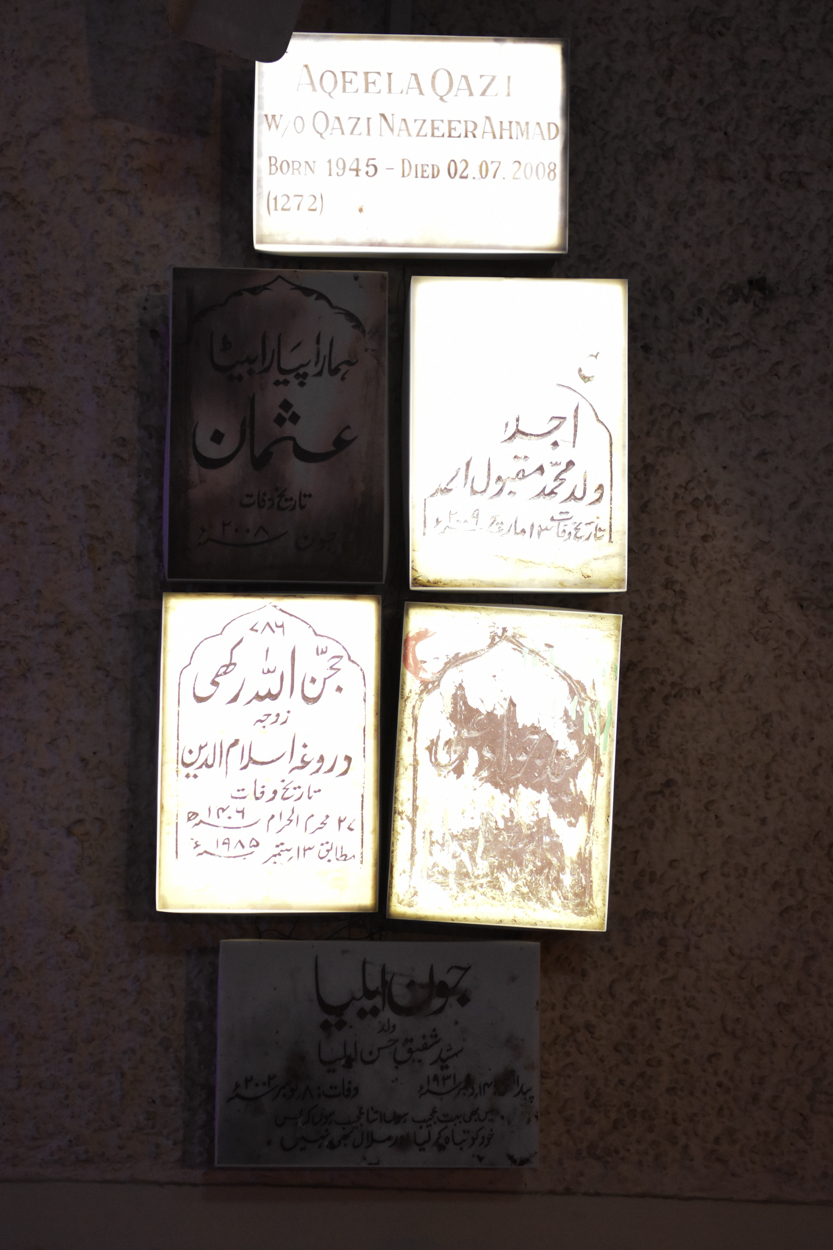
Tombstones/Katbay, 2017.
Light boxes made with cardboard, LED light, print on transparent paper
Dimensions variable
Roohi Ahmed
Born in 1966 in Karachi (Pakistan)
Lives and works in Karachi (Pakistan)
Roohi Ahmed is a multi-disciplinary artist; her work often draws upon cartographical references in order to investigate the ontological realities of human existence, in a degenerative socio-political and cultural climate. Ahmed is an Associate Professor at the Indus Valley School of Art and Architecture, Karachi and holds an MFA from the University of New South Wales, Sydney (UNSW Art & Design). She has exhibited widely in Pakistan and internationally, her work having been featured in the 11th Asian Art Biennial, Dhaka. Ahmed has coordinated the Foundation Programme at IVS, as well as having lectured at the University of Karachi’s Visual Studies Department and UNSW Art & Design, Sydney. She has participated in various international artists’ workshops, including: Britto (Bangladesh); Vasl (Pakistan); and Coast (U.K.), and has also been an artist in residence at Cicada Press (Australia), Coast (UK) and VASL (Pakistan). As well as art-making, Ahmed has curated Simply Paper! and her co-curating credits include: Michael Esson: A Survey of Drawing; Michael Kempson: A Survey of Prints, Aboriginal Dreams, and Let’s Draw the Line; and 6X6: The Labyrinth, in Karachi. Ahmed’s art practice investigates an individual’s relationship with society, and the space in which the two co-inhabit. Borrowing from the conventions of map-making and sewing, her work challenges a purely static notion of such a space to promote a temporal logic that reflects our fluctuating interrelationship with the invisible infrastructures that comprise our societal framework.
Ahmed’s work for the Karachi Biennale 2017, Encounters of Another Kind, constructs a narrative using the human figure as an interpretative tool to perceive the world. Ahmed delineates the way in which the sewn figures, eerily resembling body-bags, enable this perception: “Every mark I make articulates a response to the world around me. For me mark-making can be interpreted through the act of sewing. By relocating and bringing together different elements, their meaning and use is transformed and re-contextualized.” The sculptures are thus Ahmed’s highly personal response to the world, manifested in the act of sewing, but they also simultaneously embody an expression of physical histories as shaped by divergent narratives and contexts, forming a collective, and somewhat equivocal unconsciousness. A further layer of complexity is added when one considers the viewer’s interpretation of these objects; each a unique perspective on Ahmed’s personal response to the world around her, hence diversifying the reach of her sculptural installation.
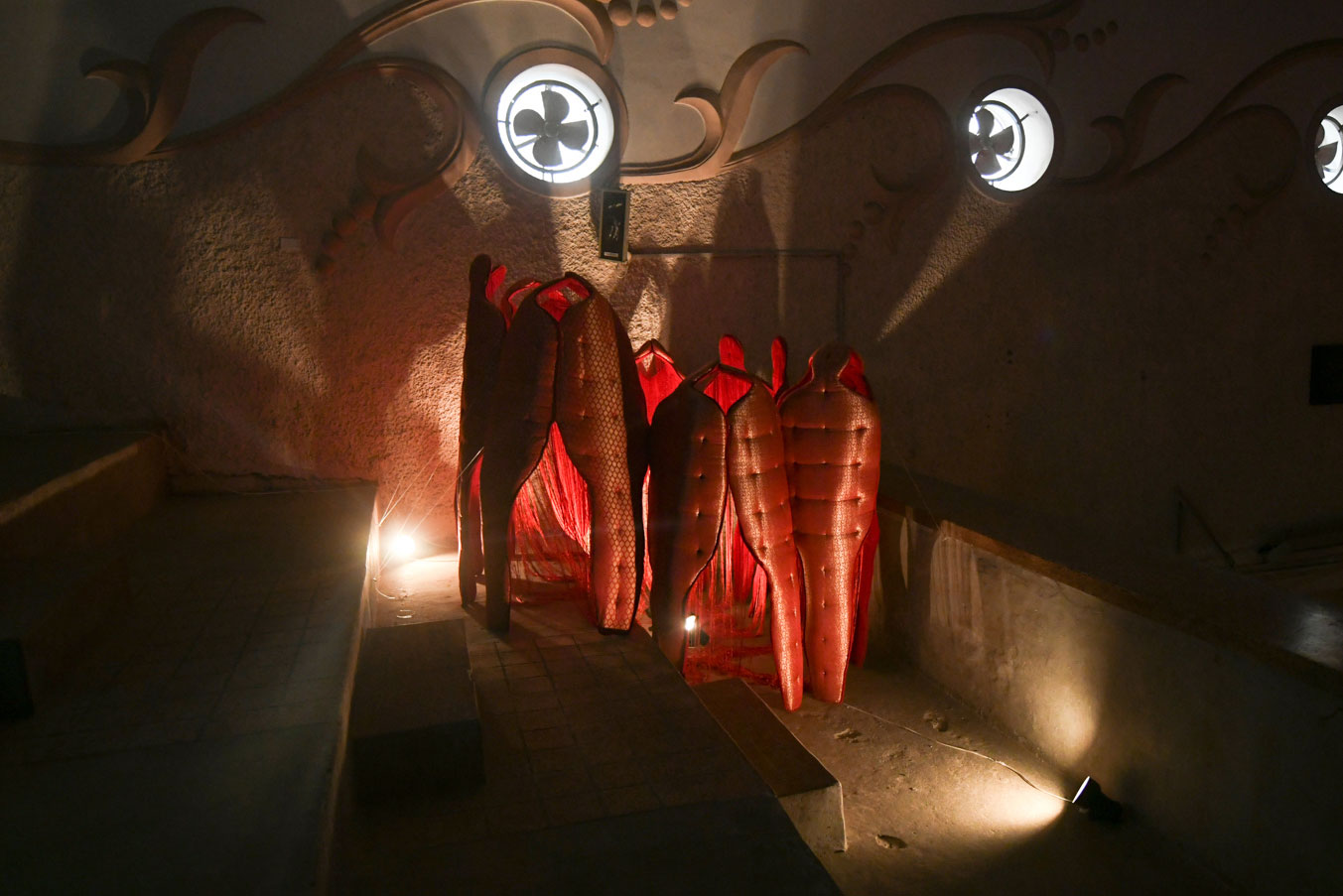
Encounters of Another Kind, 2017.
Banarsi fabric, velvet, polyester filling and metal
Approximately 56 x 157 cm. each
Elisabetta di Sopra
Born in 1969 in Pordenone (Italy)
Lives and works in Venice (Italy)
Elisabetta di Sopra graduated in 2010 from the Academy of Fine Arts in Venice; her thesis was on American artist Bill Viola. Her artistic research is expressed through the use of video language to investigate the most sensitive dynamics of everyday dimensions, as well as its unexpressed interior stories in which the female body plays a key role. She writes of her practice: “I'm the protagonist of my videos, the body is the privileged tool of expressing my work, it becomes a metaphor for our being in the world and thus the video art. Like music, like dance, it is a delicate gesture that actually materializes our feelings. Almost no dialogue exists in my videos. The body speaks through minimal gestures.” Di Sopra’s work has been featured in numerous exhibitions and festivals, including: MARCA Museum, (IT); "Possible Senses", Pizzinato Gallery, Pordenone (IT); Artist-run, Gallery Galaway, Ireland; THE PLAGIO D'ARTE D'ARTE, conference - Academy of Fine Arts Bologna; AUTHORITRATES The Showroom London; Paratissima 11, Turin (IT); and Künstlerhaus - body interference, Vienna; among many others.
Elisabetta di Sopra simply states of Dust Grains, on view at KB17: “Distant memories, those of childhood, are like dust grains in the eye...”

Still from Dust Grains, 2014.
HD Video, 3:32 min.
Courtesy the artist
Curated by Paolo De Grandis.
Muhammad Ali
Born in 1988 in Karachi (Pakistan)
Lives and works in Karachi (Pakistan)
Muhammad Ali is a multidisciplinary visual artist who graduated in 2010 from the Indus Valley School of Art and Architecture. Ali has exhibited in Pakistan and abroad with several solo and multi-person shows to his credit. He exhibited at the Bruckenthal Museum of Contemporary Art in Romania and made it as a finalist in the Sovereign Asian Art Prize and was subsequently shown in Hong Kong and South Korea. He was part of a seminal show of Pakistani artists in Dubai’s leading Lawrie Shabibi Gallery. He has recently shown in the US as well. Muhammad Ali thinks of himself as an artist of the senses who likes to manipulate, coax, create and render whole metaphysical and literal worlds of fantasy. By profession, he is a creator, an inventor and an artist, but more importantly it is his skill with emotion and what he calls his “desire radar" that allows him to flesh out ideas and engage in a meaningful dialogue.
For KB17, Muhamnmad Ali has created an installation involving the repeated image of twin elephants on the stage of the auditorium of Jamshed Memorial Hall. He writes of this work, and his accompanying performance: “The theatre and its twin dichotomies of tragedy and comedy, which encompass all the elements of human emotion as well as layers of personas which constitute our ‘realities’ is a significant inspiration. All the polarities of emotion such as compulsion and revulsion, alienation and acceptance, dreams and waking fantasies, are addressed in a manner that evokes mythological archetypes, presented as re-tellings in a critical manner.” The artist has also conceived of a separate performance for KB17, which will, in the words of the artist, “revolve around the ideas of cleanliness, purity and impurity, obsession and catharsis.”
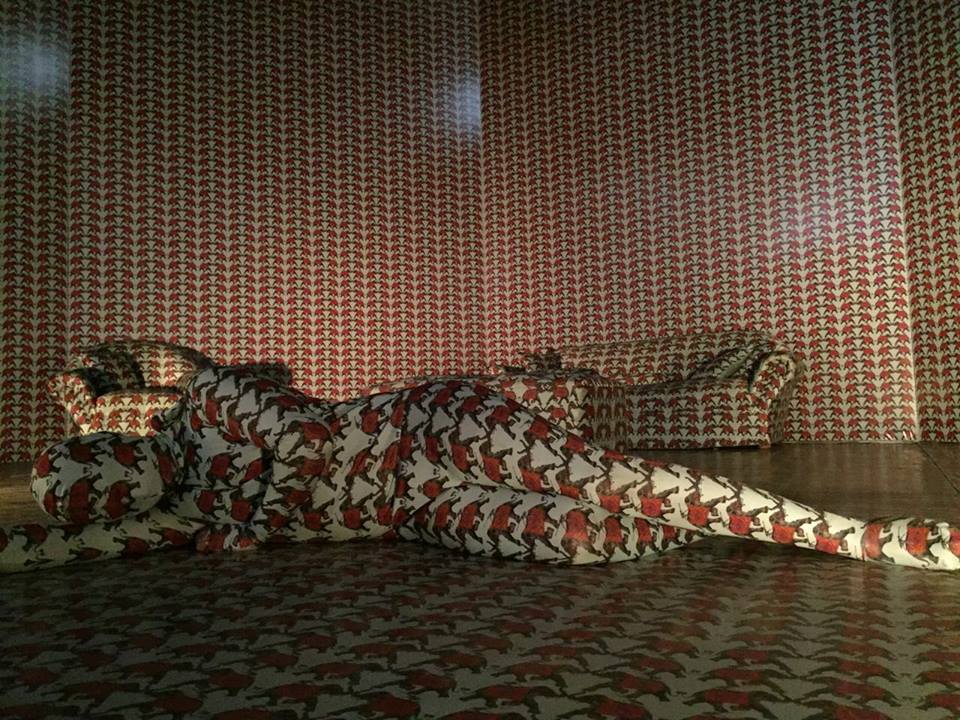
Mom! There's An Elephant In My Room, 2017.
Stickers, paint, furniture, fabric
Dimensions variable.
Performance: 3 hours.














